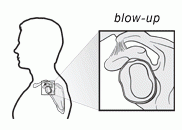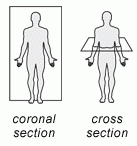

A Medical Illustrator is an artist who renders images and/or animations of the human body in various forms for the purpose of educating a specific audience. Medical illustrators undergo rigorous academic and artistic training at only a handful of schools across the country. A typical curriculum includes Human Gross Anatomy, Physiology, Pathology, Neuroanatomy, Embryology, Surgical Observation, along with a host of artistic and computer technology courses. All the Medical Illustrators at Anatomical Justice are board certified by the Association of Medical Illustrators (AMI), which is analogous to Board Certification for Physicians.
Our team of Board Certified Medical Illustrators have a combined 50 years experience in the creation of Demonstrative Evidence, which encompasses a variety of digital and traditional media. We help take the stress out of your prep work, saving you time and aggravation. Our customers rely on us to help guide them through complex issues, which plays a critical role in their case-winning strategies.
Please refer to our How to Order page.
In most cases at least one or more of the following are necessary for us to generate a quote:
Please refer to our Contact page.
Please refer to our Pricing page.
While we can work with any deadline, a typical timeframe would be six to eight (6 – 8) weeks from retainer payment and quote approval. Work cannot commence without a paid retainer and signed contract agreement. Quotes are written within two (2) weeks from the time we receive your case information. Please notify us of any specific deadline issues.
Any accepted custom project requiring a turnaround time of less than 4 weeks will be subject to an expedited case fee to be determined based on the scope of work and timeframe provided.
Yes. Medical Illustrations and Forensic Art are normally delivered to the client as a digital file, hardcopy or both. Presentation and animation formats vary as well, but most are delivered to the client in a digital format, either on a CD or DVD. Digital files can also be transmitted via e-mail or FTP.
Absolutely. While not every case requires expert review, (i.e. Focus Groups, Mediation, Demand Packages, etc.) our staff works directly with your Medical, Forensic, or Technical experts to ensure accuracy. Our ability to understand and communicate complicated medical/technical information with your experts will save you time and money. If you provide us with your experts’ contact information, we can work directly with them until they are satisfied our product is a fair and accurate representation of your case facts.
Very rarely. Our appearance in court would be required only to aid in an admission of our artwork into evidence. Our artwork is used to reinforce your expert, victim or witness testimony. We can testify only to our expertise as Medical Illustrators and Forensic Artists. We cannot testify to the medical accuracy of your case or identification of a suspect. With Medical Demonstrative Evidence, your medical expert is responsible for the accuracy of the evidence they are utilizing. In Forensic cases, it is the witness who will be identifying the accused. If a suspect can be identified based upon the artwork, law enforcement should view this as a starting point. Direct evidence will be needed to secure a favorable judgment. Please read our Disclaimer on our Privacy & Terms page.
Capturing your audience is our first priority. An effective piece of Demonstrative Art, whether for print or video, a model, or computer animation, engages and educates. It does this in a simple, concise manner without being overwhelming or confusing. Striking renderings, medical accuracy, vibrant colors, realistic movement, and fascinating compositions are but a few techniques used in creating effective Demonstrative Art. We make certain that the medium does not overwhelm the message. If the artwork distracts from your facts, you may loose your audience. Education is the benchmark for success. A lay audience must be able to follow the facts without loss of comprehension. See for yourself what our clients say about Anatomical Justice!
Illustrations or 3D models created for video, which are utilized to depict movement across time, space or to view an object from all angles.
An illustration of an individual’s face that is altered to make the individual older than depicted in the original source. Utilized by police to aide in their apprehension of criminals or find missing children.

An image on an exhibit that is an enlargement of an area within an orientation.
An illustration of a suspect’s face from witness descriptions. Utilized by police to aide in their apprehension of criminals.

Section that divides the body into anterior (front) and posterior (back) halves.

Section (sometimes called AXIAL or TRANSVERSE) that divides the body into superior (upper) and inferior (lower) halves.
A hard plastic frame that goes around each exhibit, to prevent damage.
An illustration or group of illustrations arranged on a chart.
An enlarged exhibit (usually 20” X 30” or 30” X 40”), which is used at trial.
Any art that aids in the identification, apprehension, or conviction of criminal offenders, or that aides in the location of victims or identification of unknown deceased persons.

Technique used to show objects beneath other objects.
Text or data converted into a visual representation.
An individual illustration within an exhibit.
A sheet of clear plastic that is fused over every exhibit or paper overlay. This gives the artwork a layer of protection and allows you to write of the exhibit with a dry or wet erase marker.
Line used to connect a descriptive word or phrase to the identified object.

An image on an exhibit that allows the viewer to establish the location of a blow-up.

A sheet of paper or plastic, which covers an exhibit. Used for either adding additional images to an exhibit, or allowing an individual to write on the exhibit.
A written summary of your case detailing timeframes, pricing and client contracts.

Section that divides the body into right and left halves.
Preliminary version of the exhibit based on the quote. Sketch is sent to you in color and in three formats: 8.5” X 11”, 11” X 17” and digital (either a JPEG or PDF). The exhibit is to be reviewed by you and your expert for revisions. We must receive approval by you and your expert before final exhibit is printed.
An exhibit or illustration that can be used for more than one case. Illustrations are available on our Stock image catalog.
Series of illustrations used to represent an animated sequence.
Chronologically organized representation of data pertaining to a particular case. Data is extrapolated from the information supplied by the client.
A compelling set of medical graphics begins with a FREE proposal and price quote.
"*" indicates required fields